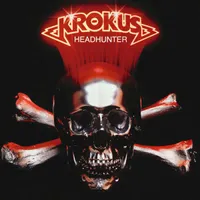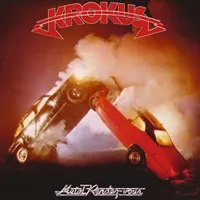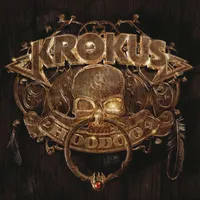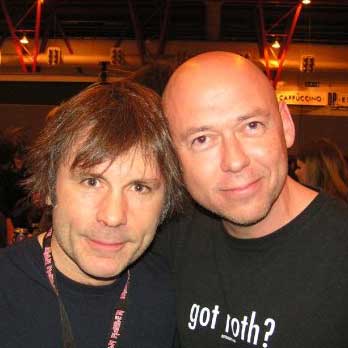The Krokus albums you should definitely own
As Switzerland’s answer to AC/DC continue to deliver farewell tour dates, we look at their must-have (and best not to have) albums

After most 50 years of rocking, Krokus are not going quietly or without a little mischief. In September 2018 the Swiss heavy metal band announced their ‘Adios Amigos’ tour, calling time on a career that began in 1975 and also aiming a sly dig at Europe’s most successful rock act, Scorpions. The Krokus statement read: “Unlike other bands on their eternal ‘farewell tour’, we will keep our word and pull the plug at the end of 2019.”
It was a provocative comment, but not entirely out of character for a band whose rise to international fame in the early 80s came with a degree of controversy. Krokus were accused of ripping off AC/DC on albums such as 1980’s Metal Rendez-vous and 1982’s One Vice At A Time, on which singer Marc Storace belted it out like Bon Scott.
Then, with 1983’s Headhunter, they were accused of ripping off Judas Priest. There was also a farcical feud with Def Leppard when Krokus opened for them on a US tour. As Leppard singer Joe Elliott recalled: “Marc Storace was nicking everything I said on stage, so when I said it the next night it was second-hand. The guy was a complete knob-head!”
But no matter, At their peak, on those 80s albums, Krokus kicked ass. And as they continue to tour – the Adios Amigo tour now promises to continue in 2024, despite Storace's promise to pull the plug in 2019 – the band still features four members of the classic 80s line-up – Storace, bassist Chris Von Rohr, and guitarists Fernando Von Arb and Mark Kohler.
It was Von Rohr who formed Krokus in the small town of Solothurn back in ’75. They started out playing progressive rock, with Von Rohr as multi-instrumentalist and lead singer. The arrival of Malteseborn Storace in 1979 transformed the band, with Metal Rendez-vous the breakthrough that led to worldwide sales of 15 million albums.
There have been numerous line-up changes across the years – astonishingly, Von Rohr was ousted from his own band in 1983. And there were many lean years in the 90s and early 2000s. But in recent times, with Von Rohr reinstated, Krokus have rallied again.
For Storace there is always the thought of what might have been. He claims he was twice approached by AC/DC, first in 1980, before Brian Johnson got the gig, and second in 2016, when Axl Rose stepped in. But Storace has had a good run with Krokus. And as Von Arb says: “Every party has to end eventually.”

One Vice At A Time (Arista, 1982)
The best album Krokus ever made is also the best AC/DC album that AC/DC never made. No matter how derivative, One Vice At A Time is a prime example of what was known, in the parlance of the times, as cranium-crunchin’ chaos.
The album’s gonzoid, singleentendre opening track Long Stick Goes Boom has the bludgeon riffola of AC/DC circa Powerage, with Marc Storace in a priapic frenzy. That energy and intensity is relentless across heavy-hitting numbers such as Playin’ The Outlaw, To The Top and a cover of The Guess Who’s American Woman (far superior to Lenny Kravitz’s later version).
The band’s biggest hit, Headhunter went gold in the US. It was also, by design, different to One Vice At A Time, which was produced by Tony Platt; the engineer on AC/DC’s Highway To Hell and Back In Black.
For Headhunter, Krokus had Judas Priest producer Tom Allom. They also had Priest singer Rob Halford backing up Storace on the wonderfully OTT heavy metal anthem Ready To Burn. There were shades of Priest in the album’s head-banging title track; a subtler mood in the power ballad Screaming In The Night; and another great cover, of Bachman Turner Overdrive’s Stayed Awake All Night. From metal’s golden age, Headhunter is a minor classic.
Metal Rendez-vous (Ariola, 1980)
The fourth Krokus album was the game changer. Storace, a powerhouse singer, lifted the band to a whole new level on the electrifying Metal Rendez-vous. At times they sounded like the new Scorpions – on the blazing Heatstrokes and the non-PC Tokyo Nights. The other influence was AC/DC.
And while this inspired the album’s standout track, Bedside Radio, a rollicking boogie, Krokus pushed their luck a little too far with Shy Kid, its opening lines stolen almost verbatim from Bon Scott’s lyrics to Ride On. Certainly Metal Rendez-vous had its flaws. but Krokus had arrived with a bang.
Hardware has always been overshadowed by what came before and after – the pivotal Metal Rendez-vous and the titanic One Vice At A Time. Hardware delivered the regulation route-one heavy-duty numbers in Mad Racket and Mr. 69. In contrast, there was real depth, an atmospheric quality and emotional power, in Celebration and Winning Man.
The surprise turn – for better and for worse – was Smelly Nelly, the band’s weirdest song. In purely musical terms, it was brilliant; a killer riff offset by spoken verses and bizarre vocal harmonies. But the lyrics were grimly sexist. Whole Lotta Rosie this was not.
28 years after One Vice At A Time, the line-up from that monolithic album was reunited for Hoodoo. Most important of all, this was Chris Von Rohr’s first recording with Krokus since Heart Attack back in 1988.
With Von Rohr as producer, the band sounded revitalised on songs that recalled the crazy days of the early 80s: Drive It In was a thunderous opening salvo, Hoodoo Woman a smoking boogie with a flavour of ZZ Top, and Keep Me Rolling another homage to AC/DC. A version of Steppenwolf’s Born To Be Wild was unnecessary. But with Storace still operating at full power, this was an emphatic, loud and proud return to form.
Dirty Dynamite (The End, 2013)
The band’s most recent release, 2017’s Big Rocks, was just a lazy covers album, but this, their last album of original material, was another late-career triumph, even if the originality of said material was questionable at best.
In the three years since Hoodoo, Krokus had added a third guitarist, Mandy Meyer, who had served the band in the 80s and 2000s. On drums was Kosta Zafiriou, ex-Pink Cream 69. But there was no deviation in style, as Krokus brazenly channelled AC/DC to brilliant effect on Hallelujah Rock N’ Roll, Go Baby Go and the title track. The only bum note was in the obligatory cover – a mauling of The Beatles’ Help!
The band’s third album was the best they made before they hired a singer of real authority in Marc Storace. Recorded in just six days, Painkiller was impressively rowdy in a rough-and-ready fashion. But it was evident that Krokus needed a proper frontman. Chris Von Rohr, while game, couldn’t sing for toffee.
The album was a curious mix, with opening track Killer evoking Steppenwolf, Get Out Of My Mind a Quo-style boogie, and Rock Me, Rock You an early sign of their AC/DC fixation, while two softer numbers, Susie and Bad Love, exposed Von Rohr’s limitations. The subsequent addition of Storace, formerly of heavy prog act TEA, was the making of them.
Never the most cerebral of men to begin with, Krokus really dumbed it down on The Blitz. In 1984, with hair-metal at the height of fashion, they tarted up their image and covered a 70s glam-rock classic, a trick that had worked for LA rockers Quiet Riot with a hit version of Slade’s Cum On Feel The Noize.
For all their gusto, however, Krokus made a mess of Sweet’s hit Ballroom Blitz, but the album still made the US Top 40. And there was much to enjoy for fans of no-brainer rock – in heroically daft, irony-free songs such as Midnite Maniac, Ready To Rock and Boys Nite Out, the latter a leftover from Bryan Adams’s Reckless.
In the 90s, as Marc Storace did a Krokus hokey cokey – in, out, in, out – the band made weak albums with singers Peter Tanner (formerly of aptly named Swiss act Headhunter) and Carl Sentance, a Welshman who fronted Persian Risk, the 80s group led by future Motörhead guitarist Phil Campbell.
But in the 2000s, Storace was back for good. And while the lineup on Hellraiser was mostly unfamiliar except for guitarist Mandy Meyer, who first played with the band in 1981, there was enough in it to make it a legitimate Krokus album: the brawn in the title track, Midnite Fantasy and Too Wired To Sleep, and the glory of Storace in full cry.
...and one to avoid
You can trust Louder
Change Of Address (Arista, 1986)
If ever a rock band handed their balls on a plate to their record company, it was Krokus with Change Of Address. Under orders from Arista to deliver radio-friendly hits, they ended up with the lamest record of their career.
Producer Tom Werman had cut great albums for Ted Nugent, Cheap Trick and Mötley Crüe, but the AOR gloss he applied to Change Of Address failed to mask the mediocrity of songs such as Hot Rock City, a gutless wannabe anthem, Let The Love Begin, a ghastly power ballad, and a cynical remake of Alice Cooper’s School’s Out. It was an act of desperation, and it bombed. A nadir for Krokus and for 80s rock.
Sign up below to get the latest from Classic Rock, plus exclusive special offers, direct to your inbox!
Freelance writer for Classic Rock since 2005, Paul Elliott has worked for leading music titles since 1985, including Sounds, Kerrang!, MOJO and Q. He is the author of several books including the first biography of Guns N’ Roses and the autobiography of bodyguard-to-the-stars Danny Francis. He has written liner notes for classic album reissues by artists such as Def Leppard, Thin Lizzy and Kiss, and currently works as content editor for Total Guitar. He lives in Bath - of which David Coverdale recently said: “How very Roman of you!”











